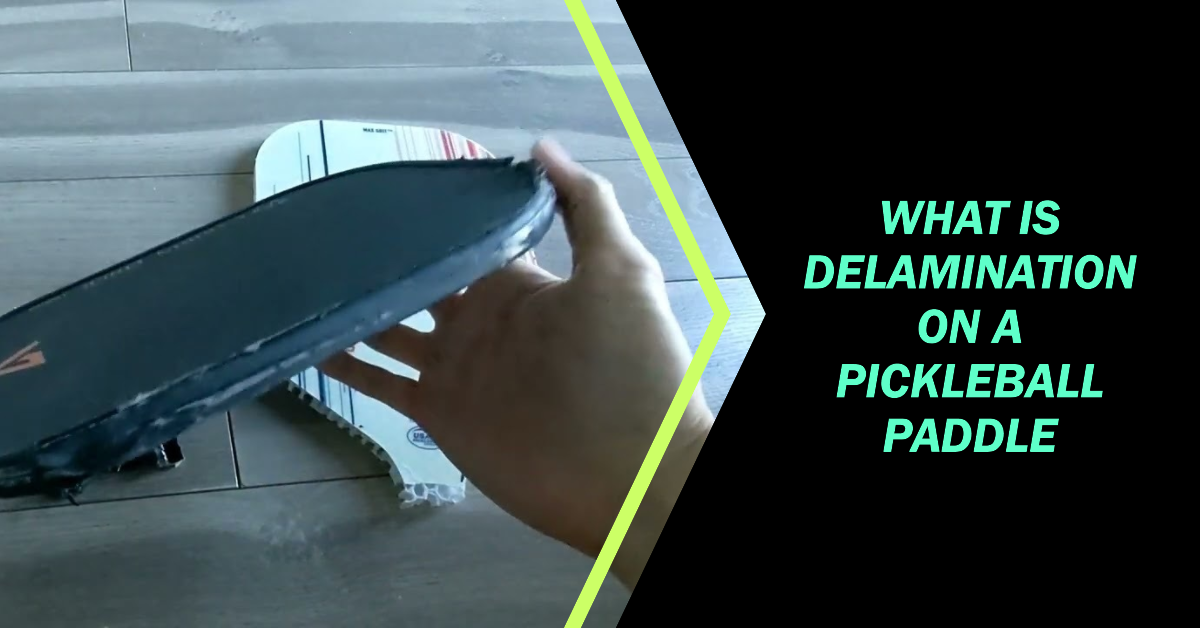Delamination is a common problem that affects pickleball paddles. It occurs when the layers of the paddle start to separate from each other, making it difficult to control shots.
Delamination can be frustrating and dangerous, especially if the paddle breaks during play. It’s important to understand why this happens to prevent it from occurring.
The most common cause of delamination is moisture. If a paddle is exposed to water or humidity, the glue holding the layers together can weaken, and the layers can start to separate. This is why it’s important to store your paddle in a dry place and avoid using it in wet conditions.
To prevent delamination, it’s important to take good care of your paddle. Store it in a dry place, avoid using it in wet conditions, and inspect it regularly for signs of wear and tear.
Causes of Delamination on a Pickleball Paddle
This section will discuss the three leading causes of delamination on a pickleball paddle.
Poor Manufacturing
One of the primary causes of delamination is poor manufacturing. When paddles are not constructed correctly, it can lead to layers coming apart, which can cause significant issues.
Sometimes, lower-quality adhesives are used to bond paddle layers, which can break down over time, causing the layers to separate.
This can also happen when the appropriate power level for a pickleball paddle is not considered during the manufacturing process.
Proposed solutions to this problem include crafting new rules regarding paddle testing and designing stronger testing methods to better test the root cause of the issue.
Excessive Wear and Tear
Another common cause of delamination is excessive wear and tear. When players use their paddles for an extended period, it can cause the layers to separate.
When players hit the ball with the paddle edge, layers can separate. To prevent delamination, store your pickleball paddle in a dry place.
Extreme Weather Conditions
Extreme weather conditions can also cause delamination on a pickleball paddle. When paddles are exposed to high humidity or temperature, it can cause the layers to separate.
This is why it is crucial to store your paddles in a dry environment and avoid exposing them to extreme weather conditions.
Additionally, long-term use without proper storage will increase the likelihood of paddle delamination due to physical wear and tear.
Effects of Delamination on Pickleball Paddle Performance
Delamination can significantly impact the paddle’s performance and the player’s ability to control the ball.
In this section, we will discuss the effects of delamination on pickleball paddle performance.
Reduced Ball Control
Decamination decreases ball control. When the paddle layers separate, the surface becomes uneven and the player may lose precision and accuracy when hitting the ball.
The soft spots caused by delamination can also cause the ball to bounce unpredictably, making it difficult for the player to anticipate its trajectory.
Altered Paddle Balance
Delamination affects paddle balance. When the paddle layers separate, the weight distribution changes, making some areas heavier or lighter. This can impair a player’s paddle control and ball hitting.
Decreased Durability
Delamination can significantly decrease the durability of a pickleball paddle. The paddle becomes weaker and more prone to damage.
This can lead to cracks, chips, and other forms of damage that can render the paddle unusable. Additionally, delamination can compromise the structural integrity of the paddle, making it more likely to break during play.
Preventing Delamination on a Pickleball Paddle
Proper Paddle Care
Paddles should be stored in a dry, consistent temperature environment and should be kept away from high moisture areas like basements or garages.
It is recommended to clean it after each use. Use a soft cloth or sponge and a mild soap solution to gently wipe down the paddle. Avoid using harsh chemicals or abrasive materials, as they can damage the surface of the paddle.
Choosing Quality Paddles
Choosing a quality pickleball paddle is another important step in preventing delamination. High-quality paddles are less likely to delaminate and will provide better control and performance on the court.
Look for paddles made from durable materials like carbon fiber or fiberglass, which are less prone to delamination than wood or aluminum.
Dealing with Delaminated Pickleball Paddles
It can be a frustrating experience for players when their pickleball paddle delaminates. Fortunately, there are options for dealing with this problem.
Repair Options
If a pickleball paddle is delaminated, a few repair options are available. The most common repair method is to use epoxy glue to reattach the layers of the paddle.
This can be done at home or by a professional. It is important to note that the repair process is not always successful and may not restore the paddle to its original performance level.
Another repair option is to cover the delaminated area with a patch. A piece of fiberglass or carbon fiber cloth and epoxy glue can be used for this.
The patch should be applied to the delaminated area and sanded down to match the paddle’s surface. This method of repair is not always successful and may have an impact on the paddle’s performance.
Replacement Considerations
If the delamination is severe or the repair options are unsuccessful, it may be time to consider replacing the pickleball paddle. When choosing a replacement paddle, it is important to consider the materials, weight, and shape of the paddle.
While repair options may be successful, replacement may be necessary if the delamination is severe or the repair options are unsuccessful.
READ MORE:

